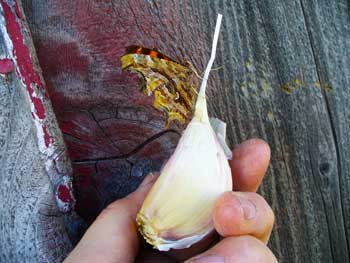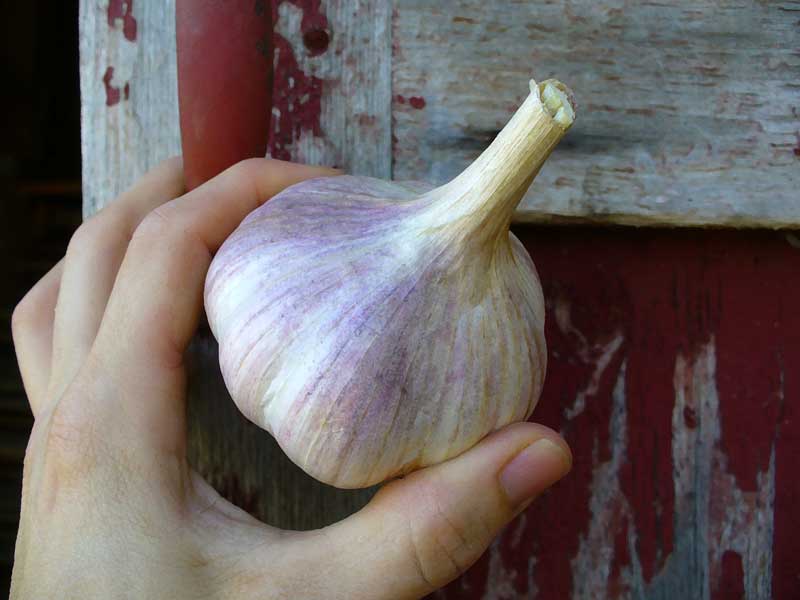How to Buy and Select Great Planting Garlic
Do you want healthy happy garlic? You need to start with good planting cloves.
Whether you grow your own planting garlic or buy it from somewhere else, it is important to choose and/or buy great planting stock. Selecting the wrong planting stock can be disastrous. It may result in bringing in a disease or pest that cannot be eradicated from your farm or garden. Or it might just mean that you get smaller garlic bulbs next year! Either way, we don't want you to be disappointed.
At Grey Duck Garlic we bought a lot of garlic from a lot of different garlic farms and seed companies as well as saving our own planting stock. Some of the garlic we bought was great and some of it wasn't so great. Quite frankly, some was bad enough that we chucked it into the garbage rather than plant it.
Luckily you can learn from us! Here our some of our tips for doing it right.
How to select great seed garlic
1) Pick a good garlic farm
If they are available, check out the reviews of the garlic farm. Be warned however, many great small farms don't have reviews because they don't sell on big commerce sites like eBay or Amazon. Once a good garlic farm is established they normally sell out of all their garlic planting stock ahead of fall and have no need to sell on other commerce sites.
See if you like the grower and their farming practices. Check out their pictures and garlic descriptions. See how long they have been growing garlic.
Ask your friends where they buy their garlic. Sometimes you can find great local garlic at your farmer's market. That is good way to hand select healthy looking bulbs that you know will grow great in your area.
Don't be discourage if a farm lacks social media connections
Some of the best garlic growers I know don't have the time or inclination to be posing for Instagram shots or throwing down tweets full of home spun wisdom. They would rather be tending their crops than posing their crops for the perfect photo op.
Not that I'm hating on Instagram or Twitter, though, because some great farmers and growers also use them. I'm just saying it is a poor metric to find the best garlic growers (or any other sort of growers actually).
Most farms do have a website and/or a Facebook page which you can check out though!
Why don't some farmers do social media anyway?
There's a name for people who are great at social media - it is Influencer NOT farmer. Social media takes time and requires prompt responses. Farming is an occupation that can sometimes have everyone working 24-7 for weeks on end. When you barely have time for a shower at the end of a long summer day making a new Facebook post seems unappealing. Even a 280 character tweet or a picture may be too much to think about.
Other farmers have the time and like to connect with people in this way. They may be good at juggling media responses with their farm workload. They also may appreciate connecting with people in the midst of their amber fields of grain.
Basically there is no wrong or right amount of social media use for growers. It all depends on what the farmer wants to cultivate and whether they have internet connectivity at their place (some rural places still do not).
Get on a waiting list for the best garlic farms
If you like the farm either get on their waiting list or pre-buy garlic! Good places sell out quickly; you will need to buy early in the season to get any garlic.
2) Look over the garlic carefully when you get it.
At our farm this was always Jane's job since she was our pickiest quality control person. You should feel, smell and look at the garlic (if you feel a bad garlic wash your hands well before picking up another garlic). Here is what you should look for to get good planting stock.
Signs of a GREAT GARLIC BULB:
 The garlic is firm, blemish free and smells slightly of garlic. The bulb bottom should be dry with no rot. There should be no moldy or off smell. If mother Nature really approves a butterfly should land on it (just kidding).
The garlic is firm, blemish free and smells slightly of garlic. The bulb bottom should be dry with no rot. There should be no moldy or off smell. If mother Nature really approves a butterfly should land on it (just kidding).
An occasional spot on a bulb or clove is not necessarily a problem. Some wear and tear on the outside garlic paper coverings is normal and is usually a sign that the garlic was harvested a little too late or that the soil was damp during harvest.
Roots starting to grow on the bottoms of clove are great. Sometimes the bottom of the bulb will look odd because all the roots are starting to poke through. That happens when there is moisture plus cold temperatures on the farm and the garlic decides it is time to grow. Think of it as getting a head start on growing your crop!
Clove and plant these good bulbs in the fall.
Signs of a SUSPICIOUS GARLIC BULB:
Garlic has a discolored bulb base, a very strong smell of garlic, numerous discolored spots, or smells of mold or fungus. The basal plate, where the roots grow, may be slightly discolored or cracked. Often something just looks or smells slightly off about the garlic.
Be very careful about planting a suspicious garlic clove. Jane would never allow us to plant them.
Signs of a BAD GARLIC BULB:
The garlic bulb is mushy or has large rotten spots. There is a strong rotten garlic smell or strong moldy smell. The bulb is a weird color or cloves are a very bright safety yellow (some garlic is naturally a golden yellow - this is fine and no cause for alarm). Cloves are dehydrated or have abnormal looking coverings. Root basal plate is cracked or swollen. Roots look rotten or moldy. The garlic may cop an attitude or have a rap sheet.
Do not plant any bulbs with these signs. Throw out the bad garlic and disinfect the area where they were stored (and your hands if you touched them).
Do not put any bad bulbs in your compost area or in any community composting area since some diseases and pests, such as garlic white rot and garlic bloat nematode, are carried on the contaminated bulbs and can be spread to your garden.

3) Be scared of Garlic White Rot and Garlic Bloat Nematodes
Two things to watch for when buying seed garlic are garlic bloat nematode and garlic white rot.
1) Garlic bloat nematode, Ditylenchus dipsac, are small nematodes who infect the garlic as it grows. They can be transported in infected or dirty garlic.
The symptoms can be mistaken for a plant disease. Symptoms include variegated plant leaves, cracked basal plate (where the roots form), soft cloves and a waxy breakdown of the cloves. The waxy breakdown can cause the outer cloves to appear bright yellow and hard.
Farms can test for garlic bloat nematode.
2) Garlic white rot can be spread through infected seed garlic. This fungus, Sclerotium cepivorum, can remain active in the soil for years and is triggered by organic sulfur compounds produced by garlic or other alliums plants. The fungus strikes at around 75 F when weather warms up in late spring or early summer.
Symptoms include a white fluffy fungus growth on the stem and base. Garlic leaves turn yellow and die. Eventually the whole plant dies. The bulb will be covered in a white fungal growth with dark microsclerotia (fungus fruiting bodies) that kills the garlic roots. Later the bulb will look black and rotten.
Some garlic that you buy at the store is infected with garlic white rot. It is extremely common in commercial garlic fields.
4) Be safe - plant new garlic in a quarantined garden area for the first couple of years.
If you want to make sure that your garlic field is not contaminated with serious garlic diseases it is best to plant any new garlic in a separated growing area for the first year or two. You can monitor the garlic to see if it shows any signs of disease. If the garlic looks good you can start growing it with the rest of your crop. If it looks bad you can destroy the garlic an make the quarantined area off limits to allium planting in the future (you can plant other crops there instead).
